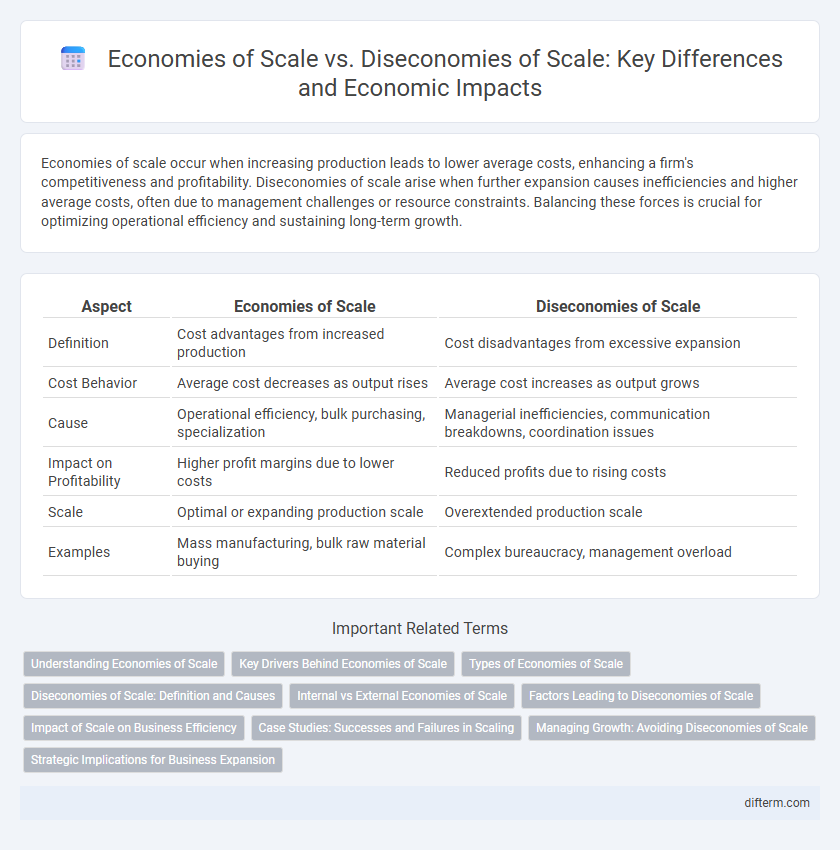Economies of scale occur when increasing production leads to lower average costs, enhancing a firm's competitiveness and profitability. Diseconomies of scale arise when further expansion causes inefficiencies and higher average costs, often due to management challenges or resource constraints. Balancing these forces is crucial for optimizing operational efficiency and sustaining long-term growth.
Table of Comparison
| Aspect | Economies of Scale | Diseconomies of Scale |
|---|---|---|
| Definition | Cost advantages from increased production | Cost disadvantages from excessive expansion |
| Cost Behavior | Average cost decreases as output rises | Average cost increases as output grows |
| Cause | Operational efficiency, bulk purchasing, specialization | Managerial inefficiencies, communication breakdowns, coordination issues |
| Impact on Profitability | Higher profit margins due to lower costs | Reduced profits due to rising costs |
| Scale | Optimal or expanding production scale | Overextended production scale |
| Examples | Mass manufacturing, bulk raw material buying | Complex bureaucracy, management overload |
Understanding Economies of Scale
Economies of scale occur when increasing production leads to lower average costs, driven by factors like bulk purchasing, specialized labor, and improved technology utilization. These cost advantages enhance a firm's competitive position by enabling lower prices or higher margins. Understanding economies of scale is crucial for businesses aiming to expand efficiently while minimizing incremental expenses.
Key Drivers Behind Economies of Scale
Key drivers behind economies of scale include technological advancements, bulk purchasing, and specialization of labor, which collectively reduce per-unit costs as production scales up. Efficient use of capital equipment and improved managerial capabilities also play critical roles in achieving cost savings. However, beyond a certain point, complexities in coordination and increased bureaucracy can lead to diseconomies of scale, where costs per unit begin to rise.
Types of Economies of Scale
Internal economies of scale include technical, managerial, financial, marketing, and network economies that reduce average costs as production expands. External economies of scale arise from industry growth, such as improved infrastructure, skilled labor pools, and supplier specialization, benefiting all firms within a region. Understanding these types is crucial for businesses aiming to optimize cost efficiency while avoiding diseconomies of scale caused by increased complexity and coordination challenges.
Diseconomies of Scale: Definition and Causes
Diseconomies of scale occur when a company's per-unit costs increase as production expands beyond an optimal point, reducing overall efficiency. Common causes include management inefficiencies, communication breakdowns, and increased complexity in coordination across departments. These factors lead to higher costs and decreased profitability in large-scale operations.
Internal vs External Economies of Scale
Internal economies of scale arise from within a company, such as improved production techniques, bulk purchasing, or managerial efficiency, leading to lower average costs as output increases. External economies of scale occur outside the firm but within an industry, including factors like improved infrastructure, supplier specialization, or industry knowledge spillovers that benefit all firms in the market. Diseconomies of scale emerge when internal inefficiencies or external constraints, such as resource scarcity or increased competition for inputs, cause average costs to rise with increased production.
Factors Leading to Diseconomies of Scale
Factors leading to diseconomies of scale include management inefficiencies, communication breakdowns, and increased bureaucratic overhead as firms grow larger. Coordination challenges and loss of employee motivation further exacerbate rising average costs. These issues cause firms to experience diminishing returns despite expanding production capacity.
Impact of Scale on Business Efficiency
Economies of scale lead to reduced average costs as production volume increases, enhancing business efficiency through bulk purchasing, operational specialization, and improved technology utilization. Diseconomies of scale occur when a company grows too large, causing inefficiencies such as communication breakdowns, increased bureaucracy, and coordination challenges that elevate average costs. Balancing scale is crucial for businesses to optimize productivity and maintain competitive advantage in markets with fluctuating demand.
Case Studies: Successes and Failures in Scaling
Economies of scale are exemplified by Walmart, which achieves lower average costs through bulk purchasing and an extensive logistics network, enabling competitive pricing and market dominance. Conversely, Boeing's 787 Dreamliner project faced diseconomies of scale, as complex coordination among numerous suppliers led to delays and cost overruns, highlighting risks in excessive scaling. These case studies demonstrate how operational efficiency improvements drive growth while overextension and management challenges trigger inefficiencies in scaling.
Managing Growth: Avoiding Diseconomies of Scale
Managing growth effectively requires balancing economies of scale to lower average costs while preventing diseconomies of scale that increase inefficiencies and operational expenses. Implementing strategic organizational structures, investing in advanced technology, and maintaining clear communication channels help firms avoid coordination problems and bureaucratic delays. Proactive management of resources and continuous monitoring of production processes ensures that growth does not lead to diminishing returns or reduced productivity.
Strategic Implications for Business Expansion
Economies of scale enable businesses to reduce average costs as production increases, enhancing competitive advantage during expansion by leveraging bulk purchasing, specialized labor, and advanced technology. Diseconomies of scale emerge when increased output leads to inefficiencies such as management complexity, communication barriers, and resource constraints, potentially raising costs and hindering growth. Strategic planning must balance these forces, optimizing operational scale to maximize cost savings while avoiding organizational inefficiencies that threaten profitability.
Economies of scale vs Diseconomies of scale Infographic

 difterm.com
difterm.com